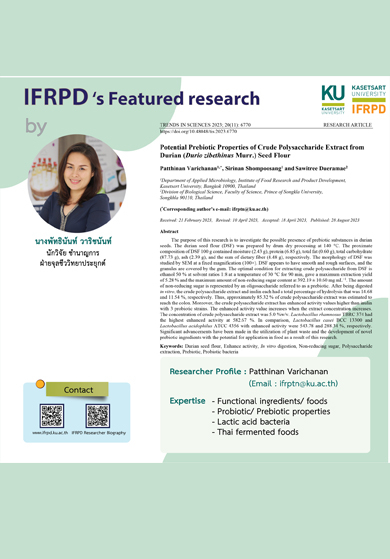บทสรุป : การศึกษาศักยภาพความเป็นพรีไบโอติกของแป้งจากเมล็ดทุเรียน โดยการสกัดพอลิแซ็กคาไรด์จากแป้งเมล็ดทุเรียนพบว่า การใช้ตัวทำละลายเป็นเอทานอลความเข้มข้น 50% อัตราส่วนระหว่างแป้งเมล็ดทุเรียนต่อตัวทำละลายที่ 1:8 โดยมีอุณหภูมิในการสกัดที่ 30 องศาเซลเซียส เป็นเวลา 90 นาที ให้ผลผลิตของสารสกัดสูงที่สุดคือ 5.28% จากนั้นนำสารกัดที่ได้ไปหาปริมาณน้ำตาลที่ไม่ถูกรีดิวซ์ (non reducing sugar) พบว่า สารสกัดพอลิแซ็กคาไรด์จากแป้งเมล็ดทุเรียนมีปริมาณน้ำตาลที่ไม่ถูกรีดิวซ์อยู่ที่ 392.19 มิลลิกรัมต่อกรัมของสารสกัด ผลการศึกษาการทนการย่อยด้วยเอนไซม์และกรดในสภาวะจำลองระบบทางเดินอาหารส่วนบนแสดงให้เห็นว่า สารสกัดพอลิแซ็กคาไรด์จากแป้งเมล็ดทุเรียน สามารถทนต่อการย่อยของเอนไซม์และกรดในสภาวะจำลองระบบทางเดินอาหารส่วนบนได้ดี มีปริมาณสารสกัดพอลิแซ็กคาไรด์ที่เหลือไปยังลำไส้ใหญ่ถึง 89.04% เมื่อนำสารสกัดพอลิแซ็กคาไรด์ไปศึกษาการส่งเสริมการเจริญของจุลินทรีย์โพรไบโอติก 3 สายพันธุ์ ได้แก่ Lactobacillus acidophilus ATCC 4356 Lactobacillus rhamnosus TBRC 374 และ Lactobacillus casei BCC 13300 พบว่า สารสกัดมีค่า Enhanced activity สูงกว่าอินนูลินซึ่งเป็นพรีไบโอติกทางการค้า โดยค่า Enhanced activity จะเพิ่มขึ้นเมื่อความเข้มข้นของสารสกัดเพิ่มขึ้น แต่มีค่าต่างกันในสายพันธุ์ของโพรไบโอติกที่ใช้ทดสอบ
Abstract : The purpose of this research is to investigate the possible presence of prebiotic substances in durian seeds. The durian seed flour (DSF) was prepared by drum dry processing at 140 °C. The proximate composition of DSF 100 g contained moisture (2.43 g), protein (6.85 g), total fat (0.60 g), total carbohydrate (87.73 g), ash (2.39 g), and the sum of dietary fiber (4.48 g), respectively. The morphology of DSF was studied by SEM at a fixed magnification (100×). DSF appears to have smooth and rough surfaces, and the granules are covered by the gum. The optimal condition for extracting crude polysaccharide from DSF is ethanol 50 % at solvent ratios 1:8 at a temperature of 30 °C for 90 min, gave a maximum extraction yield of 5.28 % and the maximum amount of non-reducing sugar content at 392.19 ± 10.60 mg mL−1. The amount of non-reducing sugar is represented by an oligosaccharide referred to as a prebiotic. After being digested in vitro, the crude polysaccharide extract and inulin each had a total percentage of hydrolysis that was 14.68 and 11.54 %, respectively. Thus, approximately 85.32 % of crude polysaccharide extract was estimated to reach the colon. Moreover, the crude polysaccharide extract has enhanced activity values higher than inulin with 3 probiotic strains. The enhanced activity value increases when the extract concentration increases. The concentration of crude polysaccharide extract was 5.0 %w/v. Lactobacillus rhamnosus TBRC 374 had the highest enhanced activity at 582.67 %. In comparison, Lactobacillus casei BCC 13300 and Lactobacillus acidophilus ATCC 4356 with enhanced activity were 543.78 and 288.34 %, respectively. Significant advancements have been made in the utilization of plant waste and the development of novel prebiotic ingredients with the potential for application in food as a result of this research.
TRENDS IN SCIENCES
2023; 20(11): 6770





